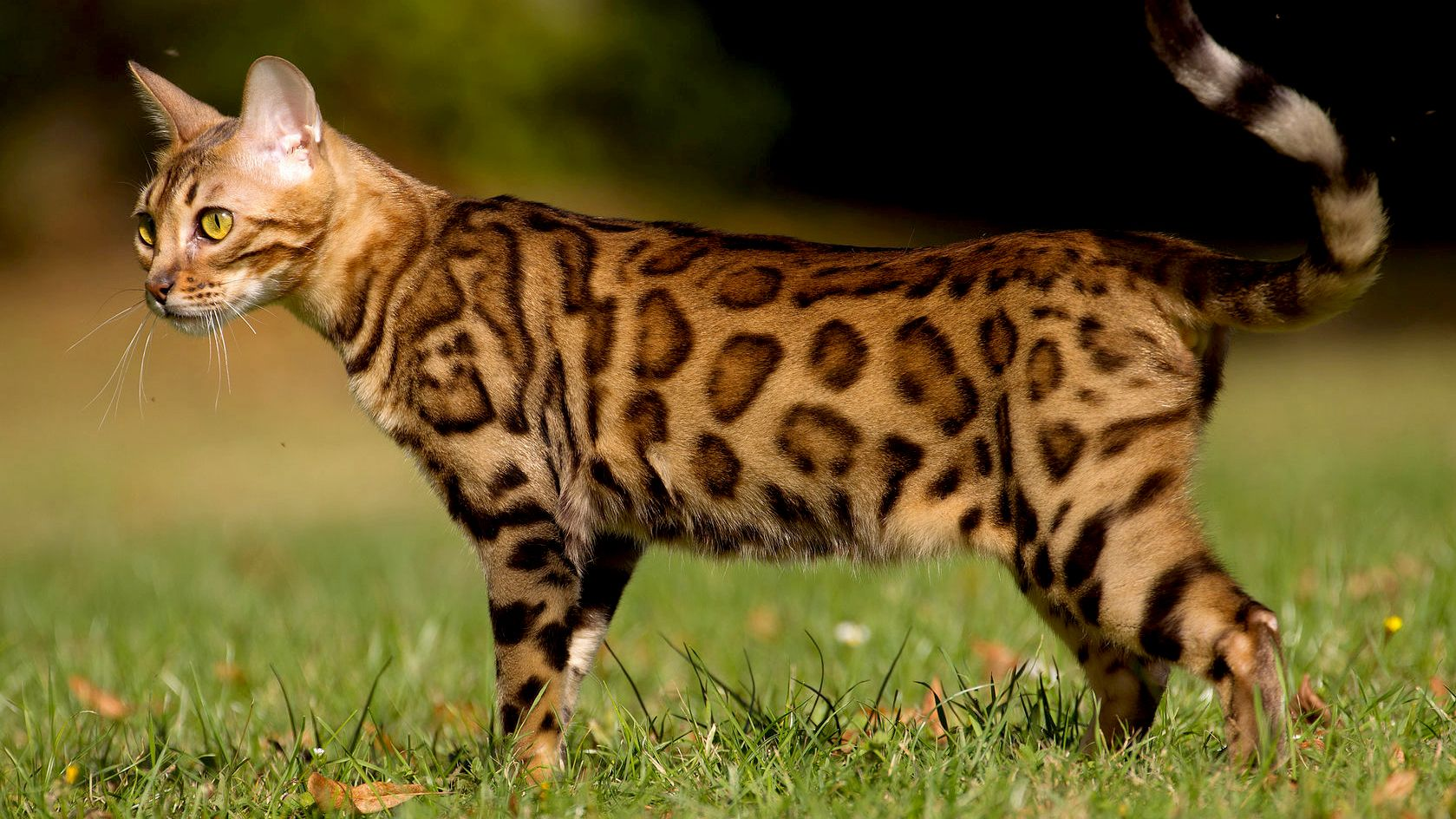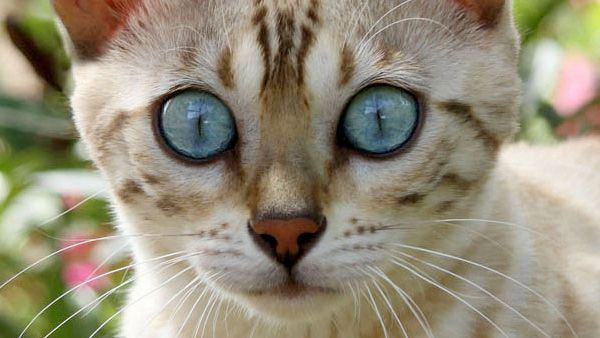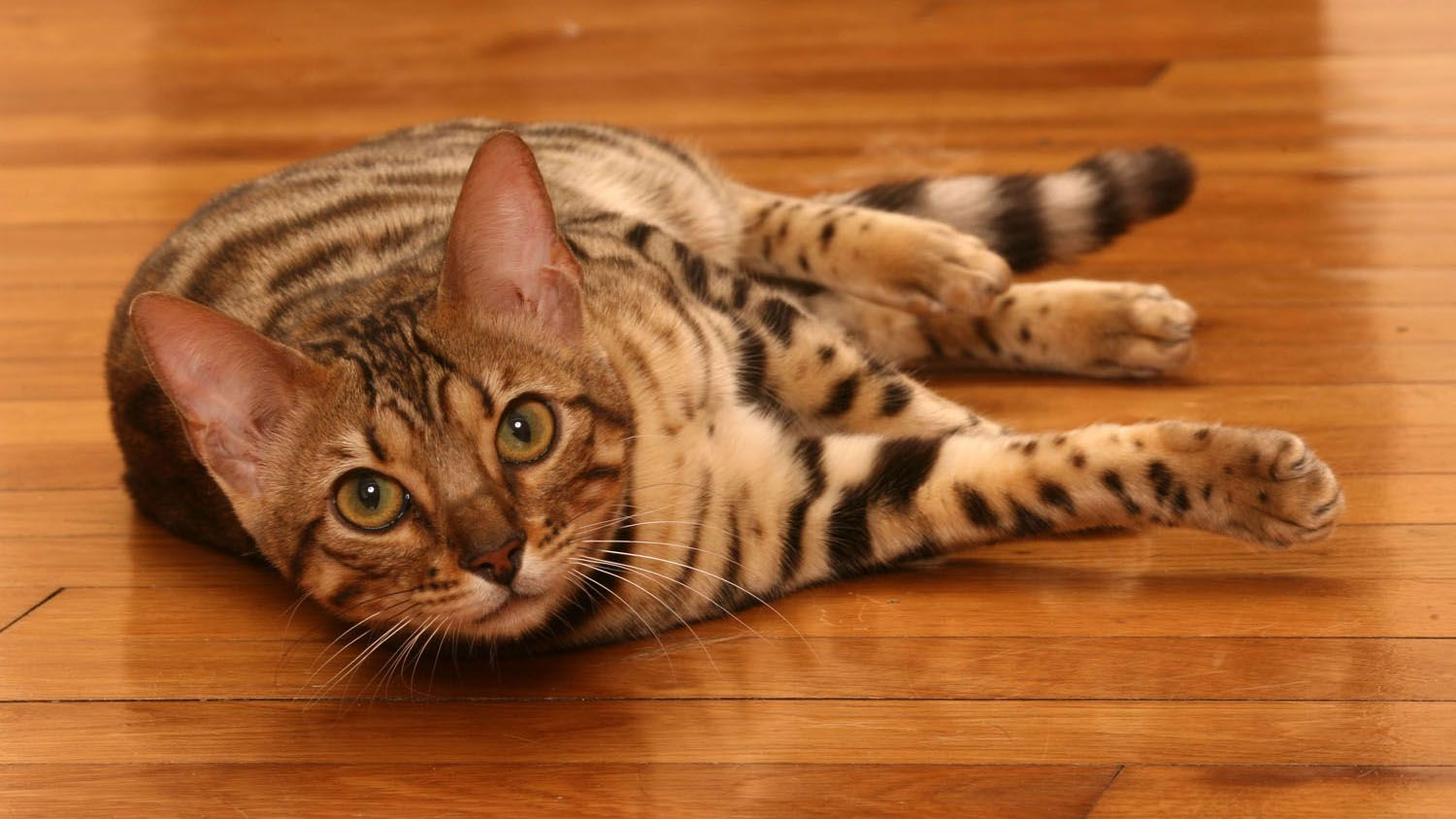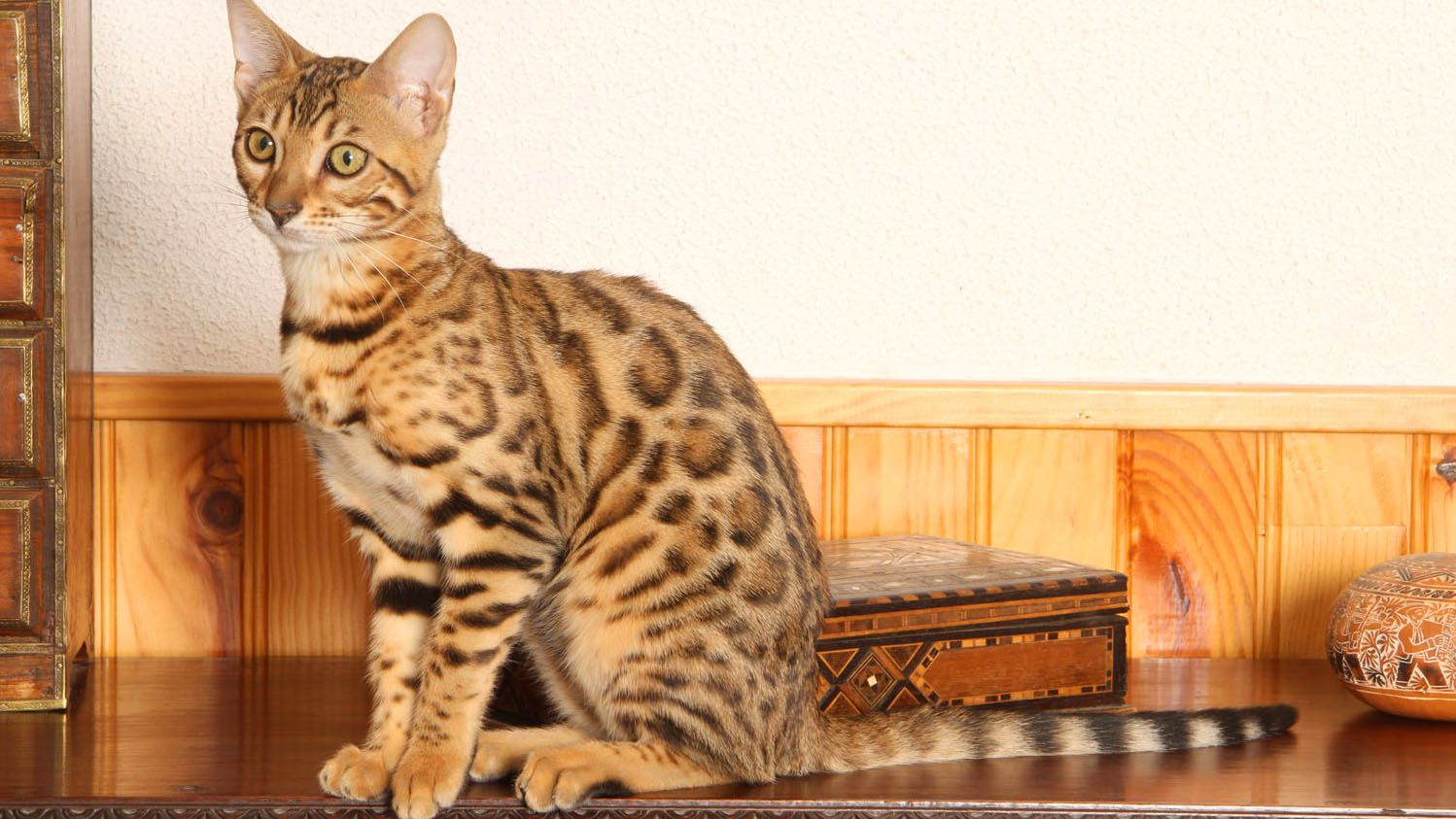Let's talk Bengals
The wild-like markings and stunning colors of the Bengal make them stand out from the rest of the feline pack. Their unique marbled coat is just one of their intriguing characteristics, along with their confidence, huge curiosity and non-stop energy. Independent as they may seem, the Bengal breed tends to get very attached to humankind, so look forward to loads of affection. Their development by a breeder in the early 60s - by crossing a domestic tabby with a wild Asian Leopard Cat - explains the two sides of the intriguing Bengal personality, not to mention their untamed look.
Official name: BengalOther names: Leopard, Leo
Origins: United States of America
Hair length
1 out of 5Shedding Level
1 out of 5Grooming needs
2 out of 5Energy level
4 out of 5Vocal
1 out of 5Family pet
5 out of 5Compatibility with other pets
4 out of 5Can stay alone
2 out of 5Environment indoor or outdoor
4 out of 5
| Male | Female |
|---|---|
| Height | Height |
| 0 - 0 cm | 0 - 0 cm |
| Weight | Weight |
| 4 - 6 kg | 3 - 5 kg |
| Life Stage | |
|---|---|
| Kitten | Adult |
| 4 to 12 months | 1 to 7 years |
| Mature | Senior |
| 7 to 12 years | From 12 years |
Hair length
1 out of 5Shedding Level
1 out of 5Grooming needs
2 out of 5Energy level
4 out of 5Vocal
1 out of 5Family pet
5 out of 5Compatibility with other pets
4 out of 5Can stay alone
2 out of 5Environment indoor or outdoor
4 out of 5
| Male | Female |
|---|---|
| Height | Height |
| 0 - 0 cm | 0 - 0 cm |
| Weight | Weight |
| 4 - 6 kg | 3 - 5 kg |
| Life Stage | |
|---|---|
| Kitten | Adult |
| 4 to 12 months | 1 to 7 years |
| Mature | Senior |
| 7 to 12 years | From 12 years |
Tailored nutrition for your Bengal

Get to know the Bengal
All you need to know about the breed
If there’s one breed that embodies the moniker “curious cat,” it’s the Bengal. There’s a confidence within them, a desire to go out and explore their domestic surroundings, and with such a brilliant animal in your midst, it’s easy to let the adventure begin. Bengals have a fearlessness that’s fascinating to watch, and they don’t mind the audience.
Another great thing about having a Bengal cat around? Their fabulously unique rosette-shaped coat. The Bengal is the only breed that’s adorned with these uncommon graphics. The Snow Bengal is another variation of the breed, which is exceptional coloration that’s mostly white. It’s a recessive color point gene that makes for the white or light brown pattern, a very unique motif indeed.
The fur of the Bengal breed can also be marbled or speckled, with its plush thickness another signature trait. Whatever the form, it’s incredible to behold.
If you value having a cat with off-the-charts energy, this is your breed. In fact, the Bengal is known to be kitten-ish even into their senior years. The unique crossbreeding of a domestic cat with one that calls the jungle home isn’t lost on this feline. They are unusually agile and athletic, and very strong yet graceful. For the highly desirable Bengal, words like magnificent, wondrous and striking definitely apply.
The Bengal is known oddly enough for being very drawn to water, sometimes coming into the shower with family members or gazing upon water being run for cooking, bathing, brushing teeth or even the mere washing of hands.

Two facts about Bengals
1. Circa 1963
One of the most recent breeds, the Bengal cat was only developed in 1963 and granted experimental status by the International Cat Association in 1983. The breed was then granted full status in 1991.
2. Teach them a trick or two
Don’t think it’s only dogs that can learn tricks. This very smart cat can too. The Bengal can be taught sit, stay, paw and even more complex tasks like fetch. So good at them, you’ll soon be wondering who is testing whom.
History of the breed
The Bengal cat takes their name from the Bengal tiger since they have a coat that resembles their distant cousin. Truth be told, the domestic breed does descend from the wild. The Bengal entered the domestic domain in 1963 after being developed by Jean Mill, an avid cat breeder from Arizona. The fan of all things feline cross-bred an Asian leopard cat with her own black domestic tomcat. The resulting Bengal had a housecat disposition and jungle cat-like athleticism.
Mill then further bred the first female kitten, producing litters from there. The Bengal was then developed at the University of California at Davis when Mill assisted in the breeding of eight kittens with an Abyssinian Burmese and Egyptian Mau.
The Bengal breed has now become much more domesticated but also a prized possession, known in feline circles as the “Rolls Royce” of cats.
The International Cat Association adopted the breed in 1983 but granted it experimental status only. The Bengal was then given full status in 1991, and in 1999 recognized as an official breed by Federation International Feline, a widely lauded federation of cat registries.
From head to tail
Physical characteristics of Bengals
1.Ears
2.Head
3.Body
4.Tail
5.Fur

Things to look out for
From specific breed traits to a general health overview, here are some interesting facts about your Bengal
Likes to climb - beware treasured chandeliers
With the jungle as their ancestral home, you can see why Bengals like to climb as high as possible - often to the highest point in the home. It’s a good idea to put away family heirlooms, expensive lighting and watch valued furniture. Their athleticism and fearlessness are among the amazing traits the Bengal has. The coolest part: their very deft paws are able to accomplish a lot of complex tasks. The Bengal has been known to turn light switches on and off!
Guinea pigs of the world, unite!
As great a family pet as they can be, the Bengal breed has a high prey drive. When the breed became known in the late 1990s, potential owners had to get a license or permit to own a Bengal. The tendency to go after their own dinner still lingers. Steer the cat clear of small pets like gerbils, mice or guinea pigs that may be kept in the same household as pets just in case your cat gets any ideas. Know too that your Bengal has deft paws that can perform many tasks - like lifting tops and picking things up!
Calories won’t need to be counted – as much.
Weight will never be an issue for the Bengal breed. They burn through calories faster than a supermodel during fashion week with their high activity rate and non-stop approach to life, not to mention their huge curiosity. The best food for Bengal cats is high-quality, containing the essential nutrients and minerals they need to best develop as they grow. Since cats need to eat little and often, feed them several times a day after carefully measuring the allowance. Never overfeed your Bengal to maintain their sleek physique.

Caring for your Bengal
Grooming, training and exercise tips
Being half jungle cat means agility and strength are a given for the Bengal. A natural athlete, they’ll need space to roam indoors and out, and to follow their natural instincts as they explore the trees and bushes of their domestic domain. Keep an eye on them when outdoors so they don’t wander off, and so they’re safe from predators, traffic or thieves, a risk for any feline.
Grooming the stunning coat of the Bengal cat will be a pleasure for anyone who enters the world of this dynamic breed. This is one cat that’s relatively easy to take care of - meaning they don’t mind it a bit. Brushing them once a week should be enough and keep the shedding in check, which is low. Clip their nails on a monthly basis for maintenance.
The Bengal cat excels at learning tricks and is easier to train than many other breeds of cats. They are highly loyal to owners and pleased when part of a group. Extremely alert and attentive, they have even been known to open doors and cupboards with their hand-like paws!
Being half jungle cat means agility and strength are a given for the Bengal. A natural athlete, they’ll need space to roam indoors and out, and to follow their natural instincts as they explore the trees and bushes of their domestic domain. Keep an eye on them when outdoors so they don’t wander off, and so they’re safe from predators, traffic or thieves, a risk for any feline.
Grooming the stunning coat of the Bengal cat will be a pleasure for anyone who enters the world of this dynamic breed. This is one cat that’s relatively easy to take care of - meaning they don’t mind it a bit. Brushing them once a week should be enough and keep the shedding in check, which is low. Clip their nails on a monthly basis for maintenance.
The Bengal cat excels at learning tricks and is easier to train than many other breeds of cats. They are highly loyal to owners and pleased when part of a group. Extremely alert and attentive, they have even been known to open doors and cupboards with their hand-like paws!
All about Bengals
Read more on this topic
Sources
- Veterinary Centers of America https://vcahospitals.com/
- Royal Canin Cat Encyclopaedia. Ed 2010 e 2020
- Banfield Pet Hospital https://www.banfield.com/
- Royal Canin BHN Product Book
Like & share this page